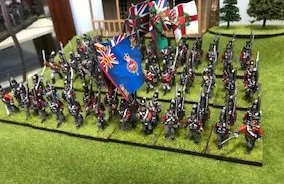The British 2nd or Light Brigade is one of my favorite commands from the Niagara 1814 campaign. Made up of the Glengarry Light Infantry and Incorporated Militia Battalion of Upper Canada, and at times a militia "brigade" or two. Native Indians who served with John Norton often were assigned to this brigade. Unfortunately I am repainting and rebasing my Indians so they are not here in the picture.
Commanding the Brigade is Lt. Col. Thomas Pearson from the Royal Welch Fusiliers. After recovering from serious wounds suffered during the Peninsula War he was transferred to Canada. Not a popular officer due to his strict discipline, he was a professional and good battlefield commander. His handling of the Light brigade in delaying the American advance in 1814 prior to Chippewa was a text book example of commanding light troops.
Dressed like the famous 95th Rifles The Glengarry Light Infantry Regiment carried muskets instead. A long serving light battalion they were recruited in the Glengarry district of Canada. A well disciplined and hard fighting unit they saw service throughout the war.
My favorite regiment for the British/Canadian army is the Incorporated Militia Battalion of Upper Canada. Made up of long service militia who volunteered for this battalion. They served as a full time battalion and deserved to be thought of a regulars. Dressed in Red coats faced green (although many officers wore red faced blue) they were issued belgic shako but many men wore the civilian round hat instead.
There were two "brigades" of militia with the army at Lundy's Lane. Called brigades they were actually a collection of understaffed regiments.
One battalion I painted in green coats with red facings. I have mixed in round hats and stovepipe shako for a more unusual look on the battlefield.
The other battalion is dressed in a mixture of civilian clothing, round hats and shakos. Officers and NCO's are in red coats to mark their superior status.
Figures from the incredible range of War of 1812 figures by Knuckleduster miniatures. I think that this brigade showed off the variety of figures from this company best. Great figures and a incredible variety of uniforms.






















































